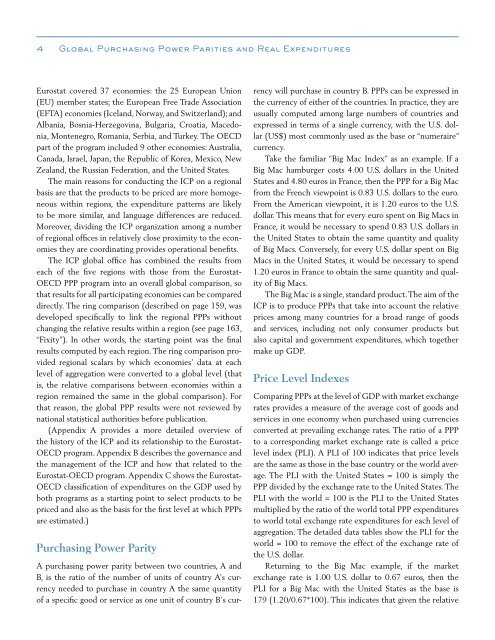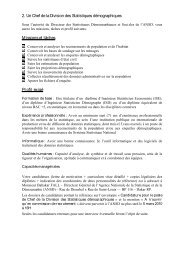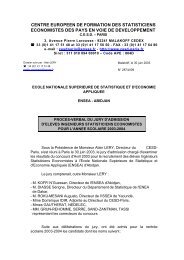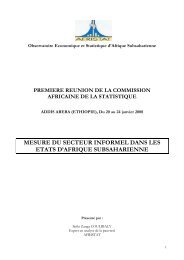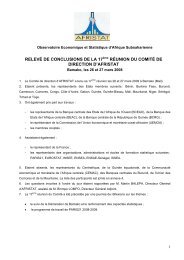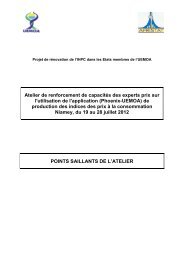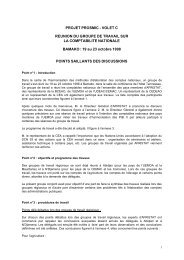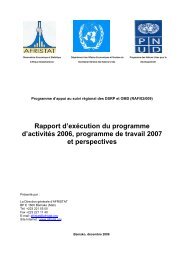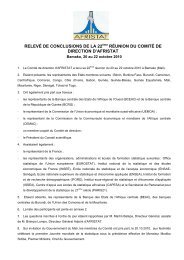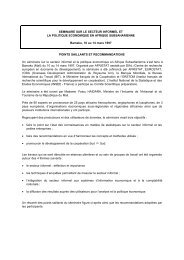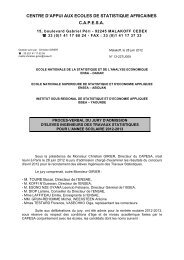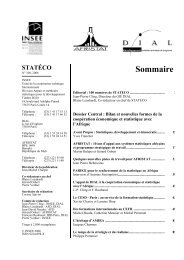Global Purchasing Power Parities and Real Expenditures - Afristat
Global Purchasing Power Parities and Real Expenditures - Afristat
Global Purchasing Power Parities and Real Expenditures - Afristat
Create successful ePaper yourself
Turn your PDF publications into a flip-book with our unique Google optimized e-Paper software.
<strong>Global</strong> <strong>Purchasing</strong> <strong>Power</strong> <strong>Parities</strong> <strong>and</strong> <strong>Real</strong> <strong>Expenditures</strong>Eurostat covered 37 economies: the 25 European Union(EU) member states; the European Free Trade Association(EFTA) economies (Icel<strong>and</strong>, Norway, <strong>and</strong> Switzerl<strong>and</strong>); <strong>and</strong>Albania, Bosnia-Herzegovina, Bulgaria, Croatia, Macedonia,Montenegro, Romania, Serbia, <strong>and</strong> Turkey. The OECDpart of the program included 9 other economies: Australia,Canada, Israel, Japan, the Republic of Korea, Mexico, NewZeal<strong>and</strong>, the Russian Federation, <strong>and</strong> the United States.The main reasons for conducting the ICP on a regionalbasis are that the products to be priced are more homogeneouswithin regions, the expenditure patterns are likelyto be more similar, <strong>and</strong> language differences are reduced.Moreover, dividing the ICP organization among a numberof regional offices in relatively close proximity to the economiesthey are coordinating provides operational benefits.The ICP global office has combined the results fromeach of the five regions with those from the Eurostat-OECD PPP program into an overall global comparison, sothat results for all participating economies can be compareddirectly. The ring comparison (described on page 159, wasdeveloped specifically to link the regional PPPs withoutchanging the relative results within a region (see page 163,“Fixity”). In other words, the starting point was the finalresults computed by each region. The ring comparison providedregional scalars by which economies’ data at eachlevel of aggregation were converted to a global level (thatis, the relative comparisons between economies within aregion remained the same in the global comparison). Forthat reason, the global PPP results were not reviewed bynational statistical authorities before publication.(Appendix A provides a more detailed overview ofthe history of the ICP <strong>and</strong> its relationship to the Eurostat-OECD program. Appendix B describes the governance <strong>and</strong>the management of the ICP <strong>and</strong> how that related to theEurostat-OECD program. Appendix C shows the Eurostat-OECD classification of expenditures on the GDP used byboth programs as a starting point to select products to bepriced <strong>and</strong> also as the basis for the first level at which PPPsare estimated.)<strong>Purchasing</strong> <strong>Power</strong> ParityA purchasing power parity between two countries, A <strong>and</strong>B, is the ratio of the number of units of country A’s currencyneeded to purchase in country A the same quantityof a specific good or service as one unit of country B’s currencywill purchase in country B. PPPs can be expressed inthe currency of either of the countries. In practice, they areusually computed among large numbers of countries <strong>and</strong>expressed in terms of a single currency, with the U.S. dollar(US$) most commonly used as the base or “numeraire”currency.Take the familiar “Big Mac Index” as an example. If aBig Mac hamburger costs 4.00 U.S. dollars in the UnitedStates <strong>and</strong> 4.80 euros in France, then the PPP for a Big Macfrom the French viewpoint is 0.83 U.S. dollars to the euro.From the American viewpoint, it is 1.20 euros to the U.S.dollar. This means that for every euro spent on Big Macs inFrance, it would be necessary to spend 0.83 U.S. dollars inthe United States to obtain the same quantity <strong>and</strong> qualityof Big Macs. Conversely, for every U.S. dollar spent on BigMacs in the United States, it would be necessary to spend1.20 euros in France to obtain the same quantity <strong>and</strong> qualityof Big Macs.The Big Mac is a single, st<strong>and</strong>ard product. The aim of theICP is to produce PPPs that take into account the relativeprices among many countries for a broad range of goods<strong>and</strong> services, including not only consumer products butalso capital <strong>and</strong> government expenditures, which togethermake up GDP.Price Level IndexesComparing PPPs at the level of GDP with market exchangerates provides a measure of the average cost of goods <strong>and</strong>services in one economy when purchased using currenciesconverted at prevailing exchange rates. The ratio of a PPPto a corresponding market exchange rate is called a pricelevel index (PLI). A PLI of 100 indicates that price levelsare the same as those in the base country or the world average.The PLI with the United States = 100 is simply thePPP divided by the exchange rate to the United States. ThePLI with the world = 100 is the PLI to the United Statesmultiplied by the ratio of the world total PPP expendituresto world total exchange rate expenditures for each level ofaggregation. The detailed data tables show the PLI for theworld = 100 to remove the effect of the exchange rate ofthe U.S. dollar.Returning to the Big Mac example, if the marketexchange rate is 1.00 U.S. dollar to 0.67 euros, then thePLI for a Big Mac with the United States as the base is179 (1.20/0.67*100). This indicates that given the relative


